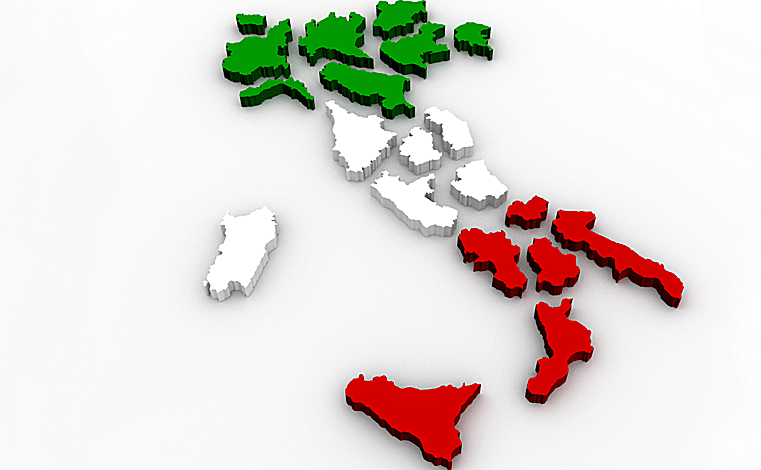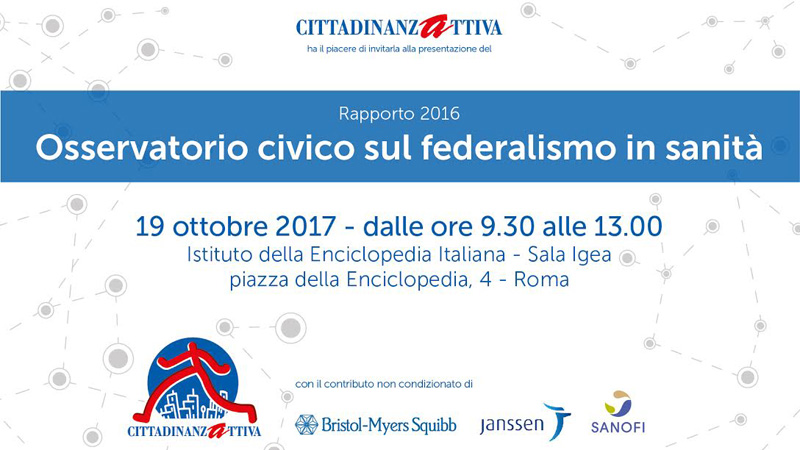
to waiting times, to the supply of medicines, from vaccination coverage to emergency management, from services for cancer patients to cancer screenings, there are still too many inequalities in access to health services that affect citizens' health . Although the regions with the greatest problems in the areas indicated are concentrated in the South, there are also positive exceptions in the South, as well as Northern Regions which struggle more than in the past to maintain performance levels in the provision of health services to citizens.
This is the case, for example, of vaccination coverage for childhood where, for the compulsory vaccinations for years (polio, diphtheria, tetanus and hepatitis B), the virtuous regions are Abruzzo, Molise and Basilicata and at the lower levels we find Friuli Venezia Giulia and the Pa of Bolzano.
This is the picture that emerges from Report of the Civic Observatory on federalism in healthcare, 2016 edition, presented today by Cittadinanzattiva-Tribunal for the rights of the patient.

From waiting times to the supply of medicines, from vaccination coverage to emergency management, from services for cancer patients to cancer screenings, there are still too many inequalities in access to health services that affect citizens' health . Although the regions with the greatest problems in the areas indicated are concentrated in the South, there are also positive exceptions in the South, as well as Northern Regions which struggle more than in the past to maintain performance levels in the provision of health services to citizens. This is the case, for example, of vaccination coverage for childhood where, for the compulsory vaccinations for years (polio, diphtheria, tetanus and hepatitis B), the virtuous regions are Abruzzo, Molise and Basilicata and at the lower levels we find Friuli Venezia Giulia and the Pa of Bolzano.
This is the picture that emerges from Report of the Civic Observatory on federalism in healthcare, 2016 edition, presented today by Cittadinanzattiva-Tribunal for the rights of the patient.
“You need one now action program for the fight against inequalities in health that attacks the deep red issue for the right to health in the south; for the reduction of inequities that cross our entire country, in the benchmark regions and not, from the urban suburbs to the internal areas. We need a plan that has objectives, actions, precise times and a monitoring system, shared between the State and the Regions, with the involvement of civic organizations and socio-health professionals ", these are the statements of Tonino Aceti, National Coordinator of the Tribunal for rights of the patient of Cittadinanzattiva. “In fact, Italy continues to be split in two, the number of regions that are unable to comply with the essential levels of assistance is increasing, despite the support of the relevant Ministries. The inconsistency between the level of quality and accessibility to services and the level of taxation is increasing, the repayment plans have produced effects from an economic point of view but in too many cases have not achieved the objective of requalification of services. It is evident that things can no longer go on like this, if on the one hand one could think of a possible new constitutional reform that starts from the bottom, restoring centrality to the effectiveness of the individual's right to health in every territory of the country in a competition positive relationship between the State and the Regions, even if the times could be long, on the other hand it is necessary to immediately understand if and what can be put in place today, under current legislation, to intervene on situations of iniquity that exist in the NHS. In other words, an action plan is needed immediately”.
Health expenditure, LEA and waiver of care: the Regions compared
In 2015 go from 3 to 5 the regions that do not comply with the Lea despite the current system of coaching the competent ministries: Molise, Calabria and Campania, which are in particularly critical conditions (from a score of 139 in 2014 to 106 in 2015), are joined by Puglia (from 162 in 2014 to 155 in 2015) and Sicily (from 170 in 2014 to 153 in 2015). Even among those that guarantee the essential levels of assistance, the discrepancies are considerable: they range from a score of 212 (the threshold of sufficiency is equal to 160) in Tuscany to 170 in Basilicata.
 In some regions, Lea and critical services correspond personal income tax levels higher and the Regions that failed to comply with the Lea, with the exception of Calabria, increased their Irpef between 2013 and 2015. In 2015, the average Irpef surtax ranged from €620 per taxpayer in Lazio to 460 in Campania and Molise, 360 from Tuscany, to 300 from Veneto, up to 270 from Basilicata. The increase from 2013 to 2015 is significant in Lazio (470€ / 620€), Piedmont (410€ / 510€), Liguria (360€ / 400€). The share of tickets per capita supported by citizens is also quite different: in 2016 it went from €32.9 in Sardinia to €96.4 in Valle d'Aosta, passing through €60.8 in Veneto, according to data from the Court of accounts.
In some regions, Lea and critical services correspond personal income tax levels higher and the Regions that failed to comply with the Lea, with the exception of Calabria, increased their Irpef between 2013 and 2015. In 2015, the average Irpef surtax ranged from €620 per taxpayer in Lazio to 460 in Campania and Molise, 360 from Tuscany, to 300 from Veneto, up to 270 from Basilicata. The increase from 2013 to 2015 is significant in Lazio (470€ / 620€), Piedmont (410€ / 510€), Liguria (360€ / 400€). The share of tickets per capita supported by citizens is also quite different: in 2016 it went from €32.9 in Sardinia to €96.4 in Valle d'Aosta, passing through €60.8 in Veneto, according to data from the Court of accounts.
The Regions with lower per capita funding shares of the SSR, with more critical LEA scores and with higher Irpef levels, also have a lower per capita private expenditure, and a higher rate of giving up on treatment, in other words an inequity below the for all to see: in fact, private spending in Campania and Sardinia amounts respectively to around €304 and €354 per year, against €798 in Valle d'Aosta and €781 in Lombardy. As if that were not enough, according to ISTAT, the share of people who have renounced to a specialist visit in the last 12 months has grown between 2008 and 2015 from 4% to 6.5% of the population. The phenomenon appears more accentuated in the midday which passes from 6.6% in 2008 to 10.1%.
Waiting lists on the rise, not only in the South. Too much variability on tickets
In particular, last year the citizens of Abruzzo, Basilicata, Campania, Liguria, Marche and Puglia reported to the Tribunal for the rights of patients the problem of the difficulty of accessing services due to waiting lists; but there are also difficulties for the citizens of Tuscany, Emilia Romagna and Umbria despite having launched regional government policies on waiting times.
Record waiting times. The longest waits are recorded for the mammography: 122 days in 2017 (+60 days compared to 2014) or almost 4 months on average, going from 89 days in the North-West to 142 days in the South and islands; follows the colonoscopy with an average of 93 days (+6 days), with peaks of 109 days in the Center and a minimum of 50 days in the North-East; for the eye examination 87 days are expected (+18 days compared to 2014) with a minimum of 74 days in the South-islands and 104 days in the North-East. Also from the latest monitoring by the Ministry of Health (2014), Calabria, Campania, Lazio and Molise are non-compliant in the indicator relating to waiting lists.
About the economic hardship due to health expenses not reimbursed by the NHS, the families of Sardinia and Sicily appear to be the most in difficulty. At the opposite extreme we find those of Emilia Romagna and Trentino-Alto Adige where only 2.6% and 2.1% respectively of resident households are in conditions of economic hardship due to health care costs.
Tickets and super tickets. The amount of tickets for health services varies from region to region. For example, for a specialist visit the price goes from 16.5 euros in the Marche to 29 in Friuli Venezia Giulia, for the analysis of the thyroid hormone (TSH) it goes from 5.46 in Liguria to 13.22 in Sardinia. For what concern super tickets on the recipe, only Basilicata, Sardinia and the Autonomous Province of Bolzano do not apply it, 8 Regions (Abruzzo, Liguria, Lazio, Molise, Campania, Puglia, Calabria, Sicily) apply the additional fee of 10 euros on each recipe, the rest apply measures alternatives to the fixed fee.
Emergency-urgency: the differences in the expectations of emergency vehicles
The time deemed acceptable for an effective rescue of healthcare workers is within 18 minutes, but the regional differences found since the last LEA monitoring are considerable: minimum peaks are recorded in Liguria (13 minutes), Lombardy (14 minutes), Lazio ( 15 minutes), Tuscany, Emilia-Romagna, Sicily, Friuli-Venezia Giulia, Marche and Piedmont. Some regions, on the other hand, register waiting intervals outside the range of normality: this is the case in particular of Sardinia (23 minutes), of Calabria and Molise (22 minutes) but above all of Basilicata (27 minutes). It is interesting to note that some regions worsen their results and in particular the Public Administration of Bolzano which goes from 10 minutes in 2014 to 19 minutes in 2015.
Also with respect to the presence of Brief Intensive Observation, an essential requirement of the I and II level DEA, there are territorial differences: the OBI in the I level DEA are present in all the structures in the north monitored by Cittadinanzattiva and SIMEU, in 81% of the cases in the center and ne 69% in the south. In the II level DEA, however, the situation changes: 100% in the centre, 78% in the north and 76% in the south.
Medicines: inequalities in access to medicines, even for cancer patients. And on generics, Italy travels at two speeds
Through the Civic Monitoring of Italian oncological structures, carried out by the Court for the rights of the sick of Cittadinanzattiva in 2016, in the 42% of the structures it takes an average of 15 days for the insertion of innovative oncological drugs in the Hospital Therapeutic Handbook (PTO). Then there are healthcare facilities that take 2 to 3 months (7%) and up to 120 days, i.e. 4 months (9%), to introduce innovative drugs after national approval. Furthermore, only the 52% of the structures provides for procedures for supporting the costs of medicines not passed on by the NHS.
At the territorial level, for the inclusion of oncological drugs in the hospital therapeutic handbook, it ranges from a minimum of 1 day to a maximum of 90 days in the North, from a minimum of 3 to a maximum of 200 days in the Center and from a minimum of 7 to a maximum of 90 days in the South and Islands.
On the front of equivalent drugs, a more widespread use is recorded in the Autonomous Province of Trento with 41.1%, while Basilicata is the one that uses the least with 18.3%. Emilia-Romagna (34.3%), Friuli-Venezia Giulia (33.2%), Liguria (30%), Lombardy (36.8%), Tuscany (32.7%) and Valle d'Aosta (32.2%) present data stackable.
In terms of spending, on the other hand, compared to the rest of Italy, those who live in Emilia Romagna (25.5%), Lombardy (24%), the PA of Trento (28.5%), buy more equivalent medicines while the lowest expenditure is recorded in Calabria (12%), Basilicata (12.3%) Campania and Sicily (13.4%), Puglia (14.8%) and Molise (14.7%). The Italian average expenditure on generic medicines is 18.8% compared to total private pharmaceutical expenditure.
Safety of care and technological modernization, a priority for everyone
24 billion is the investment for safety and structural and technological modernization. These resources were spent by the PA of Bolzano, Friuli Venezia Giulia and Calabria which allocated 100% of resources to hospitals, followed by Campania, PA of Trento, Puglia. In 2015, however, citizens continued to report to the Tribunal for the rights of the patient, the dilapidation of the structures (28,1%), poor hygienic conditions (30%) and problems with machinery and tools because they were broken or malfunctioning (42%). Also according to the 2017 report of the Court of Auditors, more than 30% of the equipment is more than 10 years old; only the 30% of the Tacs has been tested for less than 5 years and this percentage drops to the 27% in the south of the country.
About infections care-related, it is very difficult to find data at both national and regional level; according to the Annual Report on hospitalization activities (SDO) of the Ministry of Health, published in 2015, the hospital infections registered are increasing (22,000 in 2015, almost 4,000 more than in 2007) in most Regions, with the exception of the autonomous Provinces of Trento and Bolzano, Friuli Venezia Giulia, Tuscany, Abruzzo, Molise, Puglia and Sicily.
Vaccination coverage and screening adhesions: prevention is still a Cinderella
On no childhood vaccinations, Italy achieves the recommended coverage of the 95% in all Regions. Not even on the four that have been mandatory for years, i.e. polio, diphtheria, tetanus and hepatitis B, where in any case the regional differences are notable: virtuous Abruzzo, Molise and Basilicata (coverage higher than 97%), Calabria and Sardinia (coverage higher than 95%), at below are Friuli Venezia Giulia (89%) and the Pa di Bolzano (85%).
As regards Measles-Mumps-Rubella, the average coverage is 87%, the Regions with the highest coverage are Lombardy (>93%) and Piedmont (>91%); are over 90% Sardinia and Basilicata. The lowest levels are recorded in the Autonomous Province of Bolzano (>67%) and Molise (73.51%).
On the flu vaccine for the over 65s, we are stuck at just over 50% (compared to the recommended 75%): vaccination coverage is higher in Umbria with 63.1%; Calabria and Puglia follow, above 57%. The lowest figure is recorded in the Autonomous Province of Bolzano 37.3%.
Cancer screenings. The Court of Auditors certifies that, with the exception of Abruzzo, Molise and Piedmont which reach the minimum score of 7 in the share of residents who have joined the regional screening programs, the other Regions in the recovery plan are well below this threshold : Calabria (1), Puglia (2), Campania and Sicily (3), Lazio (5).
Mammography screening. Despite the increase in invitations delivered in 2015, territorial inequalities remain: the invitation to the North reaches almost all women, over 9 out of 10; at the Center just under 9 out of 10 receive an invitation; in the south only 6 out of 10 women.
The highest number of women who underwent mammography in the period 2013-2015, within the screening programmes, was recorded in Emilia Romagna (78%), followed by the Autonomous Province of Trento (77%). At a distance of 10 percentage points (between 69% and 67%) are placed: Friuli Venezia Giulia, Lombardy, Umbria, Tuscany, Valle d'Aosta, Basilicata. The lowest absolute number of women who underwent a mammogram (both inside and outside the screening programmes) was recorded in Campania (50%), Calabria (51%), Sicily (51%). The highest percentage of women who underwent mammograms outside of screening programmes, between 27% and 29%, was recorded in: Lazio and Puglia (both 29%); followed by Marche (28%) and finally, with 27%, Liguria and Campania. The lowest absolute number of women who have undergone a mammogram is recorded in Campania, Calabria and Sicily.
Cervical screening. Valle d'Aosta (77%) is confirmed as the Region with the highest number of women who undergo the test in screening programmes. In Campania, Puglia, Abruzzo, Lombardy, Lazio and Liguria there is a higher percentage of women who carry out the test outside the screening programmes, compared to those who carry it out within organized and free programmes.
Colorectal screenings. Despite the fact that half a million more invitations were sent in 2015, compared to 2014, for a total of about 5 million and three hundred and fifty thousand people invited, adherence to the 43% has decreased: in some Regions, not only is the level of adherence to screenings low, but even the tests performed outside the programs are higher than the screenings themselves: this is the case of Calabria (5% screening/6% outside screening), Puglia (6% screening/7% outside screening), Abruzzo (14 screening/16 outside screening). Also in this case, the highest percentages of execution of the test in screening programs are recorded in PA Trento (67%), Valle d'Aosta (66%), Emilia Romagna and Lombardy (65%).
Oncology: different services and waiting times from region to region
Although the incidence of tumours, in particular of some, is lower in the South, in the southern regions and in the islands the survival rate five years after diagnosis is lower than in the North (49% vs 52%, while in the Center it stands at 51%) .
in Italy, the oncological networks are active only in 6 regions (mainly the north) and also have very different characteristics: Piedmont, Lombardy, Tuscany, Trentino, Umbria and Veneto. Instead, Abruzzo, Calabria, Basilicata, Marche, Molise and Sardinia are missing. In the remaining regions they are being implemented.
Oncological facilities and services. If we consider the structures with medical oncology services, we range from values such as that of Molise with 19.15 per million inhabitants, to regions such as Basilicata with 5.20 structures and Puglia (4.65 structures). As far as facilities with radiotherapy services are concerned, the numbers range from Tuscany with 4 services per million inhabitants, Emilia Romagna (3.6), Lombardy (3.2), to the meager numbers of Campania with 1.71 services per million inhabitants, Puglia (1.71) and Basilicata (1.73).
Wait times. As for the waiting times for the diagnostic and specialist services in the event of a suspected diagnosis, the data from the Monitoring of oncological structures of Cittadinanzattiva show that in the North the 80% of people in emergency conditions accesses within the established 72 hours. Worse percentages can be found in the Center (72%) and in the South (77%). More timely access tosurgery following an oncological diagnosis. In the North, citizens' 100% accesses within 60 days, 88% in the Center and 77% in the South. Rather sore point appears to be access to radiotherapy and at thechemotherapy which, especially in the Center and the South, is not guaranteed within 30 days in the 100% of the structures but only in the 84% and 86% respectively.
Action program to combat inequalities in health
1) Implementation, not just formal acknowledgment, of approved measures (laws, decrees, and in particular state-region agreements). In particular, it is necessary to increase the monitoring and verification capacity of the Ministry of Health vis-à-vis the regions and to apply the intervention tools, such as the commissioner, in cases of non-compliance, as envisaged by art. 120 Constitution.
2) Strengthen the current Lea monitoring system by innovating it through:
– the participation of citizens' representatives, a third party element, in the National Commission for updating the LEA; – updating the indicators by including priority issues for citizens.
3) Review the 'instrument' of repayment plans: from the almost exclusive verification of the accounts, to the strengthening of the guarantee of services.
4) Reduce and intervene on the current differences in the performance of the regional and corporate administrative systems.
5) Eliminate the duplication of decision-making centres, responsibilities and functions between the different levels (central, regional and company), as occurs in the pharmaceutical assistance sector.
6) Work on the revision of the rules on co-payments, first of all abolishing the super-ticket, an unfair tax which has fueled inequalities and increased the costs of healthcare services, forcing people to give up treatment, even though they need it.
The report is presented with unconditional contributions from Bristol-Meyers Squibb, Janssen and Sanofi
Active citizenship – 19 October 2017
Related news: AIFA, L'excerpt on Momonitoring of National and Regional Pharmaceutical Expenditure (January / June 2017)





